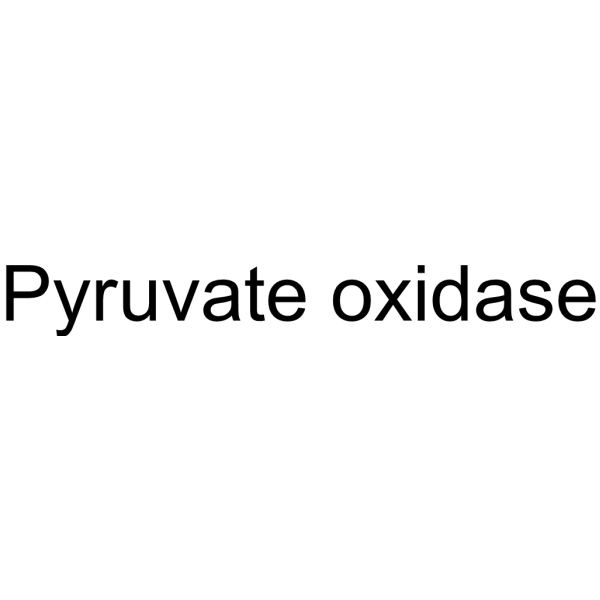Pyruvate Oxidase

Pyruvate Oxidase structure
|
Common Name | Pyruvate Oxidase | ||
|---|---|---|---|---|
| CAS Number | 9001-96-1 | Molecular Weight | N/A | |
| Density | N/A | Boiling Point | N/A | |
| Molecular Formula | N/A | Melting Point | N/A | |
| MSDS | USA | Flash Point | N/A | |
|
Alternating sites reactivity is a common feature of thiamin diphosphate-dependent enzymes as evidenced by isothermal titration calorimetry studies of substrate binding.
Biochemistry 52(15) , 2505-7, (2013) Thiamin diphosphate (ThDP)-dependent enzymes play vital roles in cellular metabolism in all kingdoms of life. In previous kinetic and structural studies, a communication between the active centers in terms of a negative cooperativity had been suggested for so... |
|
|
A luminol chemiluminescence method for sensing histidine and lysine using enzyme reactions.
Anal. Biochem. 443(1) , 22-6, (2013) The analysis of free amino acids in urine and plasma is useful for estimating disease status in clinical diagnoses. Changes in the concentration of free amino acids in foods are also useful markers of freshness, nutrition, and taste. In this study, the specif... |
|
|
Using substrate analogues to probe the kinetic mechanism and active site of Escherichia coli MenD.
Biochemistry 50(40) , 8712-21, (2011) MenD catalyzes the thiamin diphosphate-dependent decarboxylative carboligation of α-ketoglutarate and isochorismate. The enzyme is essential for menaquinone biosynthesis in many bacteria and has been proposed to be an antibiotic target. The kinetic mechanism ... |
|
|
TCA cycle involved enzymes SucA and Kgd, as well as MenD: efficient biocatalysts for asymmetric C-C bond formation.
Org. Lett. 15(3) , 452-5, (2013) Asymmetric mixed carboligation reactions of α-ketoglutarate with different aldehydes were explored with the thiamine diphosphate dependent enzymes SucA from E. coli, Kgd from Mycobacterium tuberculosis, and MenD from E. coli. All three enzymes proved to be ef... |
|
|
α-Hydroxy-β-keto acid rearrangement-decarboxylation: impact on thiamine diphosphate-dependent enzymatic transformations.
Org. Biomol. Chem. 11(2) , 252-6, (2013) The thiamine diphosphate (ThDP) dependent MenD catalyzes the reaction of α-ketoglutarate with pyruvate to selectively form 4-hydroxy-5-oxohexanoic acid 2, which seems to be inconsistent with the assumed acyl donor role of the physiological substrate α-KG. In ... |
|
|
Effect of acetate formation pathway and long chain fatty acid CoA-ligase on the free fatty acid production in E. coli expressing acy-ACP thioesterase from Ricinus communis.
Metab. Eng. 14(4) , 380-7, (2012) Microbial biosynthesis of fatty acid like chemicals from renewable carbon sources has attracted significant attention in recent years. Free fatty acids can be used as precursors for the production of fuels or chemicals. Wild type E. coli strains produce fatty... |
|
|
Metabolic engineering for acetate control in large scale fermentation.
Methods Mol. Biol. 834 , 283-303, (2012) Escherichia coli is the most commonly used microorganism for production of recombinant proteins for different applications. Acetate accumulation during aerobic growth on glucose has significant negative impact on recombinant protein production in Escherichia ... |
|
|
Development of an amperometric assay for phosphate ions in urine based on a chemically modified screen-printed carbon electrode.
Anal. Biochem. 393(2) , 242-7, (2009) An amperometric assay for the determination of inorganic phosphate (Pi) in urine has been developed without the need for sample preparation. A screen-printed carbon electrode modified with the electrocatalyst cobalt phthalocyanine (CoPC-SPCE) and covered with... |
|
|
Quantitation of the cancer marker LASA using immobilized enzymes in a semiautomated system.
Int. J. Biol. Markers 24(2) , 107-11, (2009) Cancer patients are found to have elevated serum levels of lipid-associated sialic acid (LASA). LASA measurement provides a valuable test for the diagnosis of human cancer. The currently used measurement methods are tedious and nonselective. Here we report a ... |
|
|
Crystalline flavin pyruvate oxidase from Escherichia coli. I. Isolation and properties of the flavoprotein.
Arch. Biochem. Biophys. 116(1) , 168-76, (1966)
|